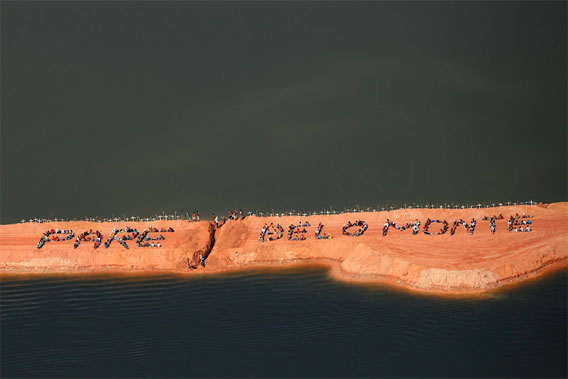
Belo Monte protest. Photo credit: Atossa Soltani/ Amazon Watch / Spectral Q.
In an symbolic protest of the giant Belo Monte Dam, Friday morning some 300 locals dug a channel in an earthen dam that blocks a portion of the Xingu River and serves as the first step for the controversial hydroelectric project, reports Amazon Watch.
“In the early morning hours, three hundred women and children arrived in the hamlet of Belo Monte on the Transamazon Highway, and marched onto a temporary earthen dam recently built to impede the flow of the Xingu River. Using pick axes and shovels, local people who are being displaced by the project removed a strip of earthen dam to restore the Xingu’s natural flow,” stated a press release.
The stunt was coordinated to draw attention to the project prior to the opening of the Rio+20 conference to be held next week. Demonstrators have gathered in the town of San Antonio and Altamira, a city that will be partly flooded by the dam, for Xingu+23, a multi-day protect against the dam, which was originally stopped 23 years ago by an uprising by environmentalists and indigenous groups.
“This battle is far from being over,” said Antonia Melo, the coordinator of Xingu Vivo Movement against the dam. “This is our cry: we want this river to stay alive. This dam will not be built.”
“We, the people who live along the banks of the Xingu, who subsist from the river, who drink from the river, and who are already suffering from of the most irresponsible projects in the history of Brazil are demanding: Stop Belo Monte.”
Belo Monte will flood more than 40,000 hectares of rainforest and displace tens of thousands of people. The project will impede the flow of the Xingu, which is one of the Amazon’s mightiest tributaries, disrupting fish migrations and potentially affecting nutrient flows in a section of the basin.
Environmentalists say the Brazilian government’s support of the project is at odds with the green image it projects in international talks and as host of the upcoming United Nations Conference on Sustainable Development. Green groups note that Brazil is planning dozens of dams in the Amazon Basin.
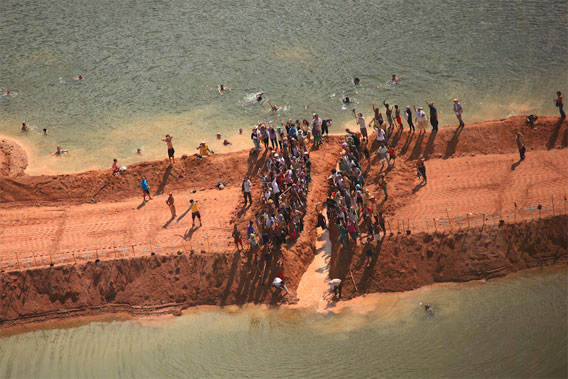
Three hundred indigenous people, small farmers, fisherfolk, and local residents occupied the Belo Monte Dam project, removing a strip of earth to restore the Xingu’s natural flow and “freeing the river.” Participants gathered in formation spelling out the words “Pare Belo Monte” meaning “Stop Belo Monte” to send a powerful message about the devastating impacts of the dam on the eve of the UN Rio+20 Summit. Their message is that projects that destroys livelihoods and the environment and that violate indigenous rights cannot be called “Clean Energy”. They are demanding the cancellation of the $18 billion Belo Monte dam project. Caption courtesy of Amazon Watch. Photo credit: Atossa Soltani/ Amazon Watch / Spectral Q

Photo credit: Atossa Soltani/ Amazon Watch / Spectral Q

Photo credit: Mitchell Anderson
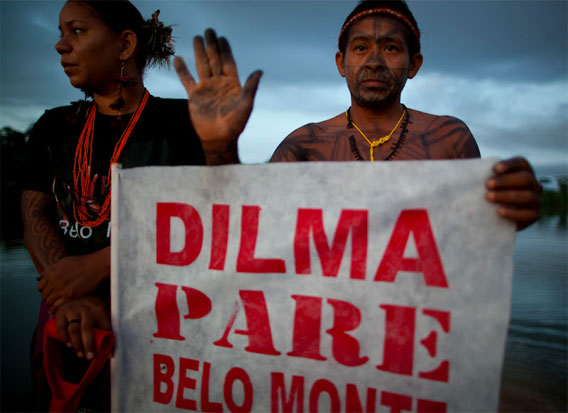
Photo credit: Mitchell Anderson
Related articles
Tropical dams are a false solution to climate change
(05/27/2012) Tropical dams emit considerably more greenhouse gas emissions than their temperate counterparts yet are being treated as a solution to climate change, warns a report published in Nature Climate Change.
Will mega-dams destroy the Amazon?

(04/18/2012) More than 150 new dams planned across the Amazon basin could significantly disrupt the ecological connectivity of the Amazon River to the Andes with substantial impacts for fish populations, nutrient cycling, and the health of Earth’s largest rainforest, warns a comprehensive study published in the journal PLoS ONE. Scouring public data and submitting information requests to governments, researchers Matt Finer of Save America’s Forests and Clinton Jenkins of North Carolina State University documented plans for new dams in Bolivia, Brazil, Colombia, Ecuador, and Peru.
Pictures: Destruction of the Amazon’s Xingu River begins for Belo Monte Dam
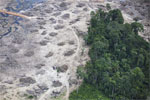
(04/18/2012) The Xingu River will never be the same. Construction of Belo Monte Dam has begun in the Brazilian Amazon, as shown by these photos taken by Greenpeace, some of the first images of the hugely controversial project. Indigenous groups have opposed the dam vigorously for decades, fearing that it will upend their way of life. Environmentalists warn that the impacts of the dam—deforestation, methane emissions, and an irreparable changes to the Xingu River’s ecosystem—far outweigh any benefits. The dam, which would be the world’s third largest, is expected to displace 16,000 people according to the government, though some NGOs put the number at 40,000. The dam will flood over 40,000 hectares of pristine rainforest, an area nearly seven times the size of Manhattan.
Belo Monte Dam: A spearhead for Brazil’s dam-building attack on the Amazon?
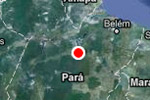
(03/23/2012) Brazil’s Belo Monte Dam on the Xingu River is now under construction despite its many controversies. The Brazilian government has launched an unprecedented drive to dam the Amazon’s tributaries, and Belo Monte is the spearhead for its efforts. Brazil’s 2011-2020 energy-expansion plan calls for building 48 additional large dams, of which 30 would be in the country’s Legal Amazon region1. Building 30 dams in 10 years means an average rate of one dam every four months in Brazilian Amazonia through 2020. Of course, the clock doesn’t stop in 2020, and the total number of planned dams in Brazilian Amazonia exceeds 60.